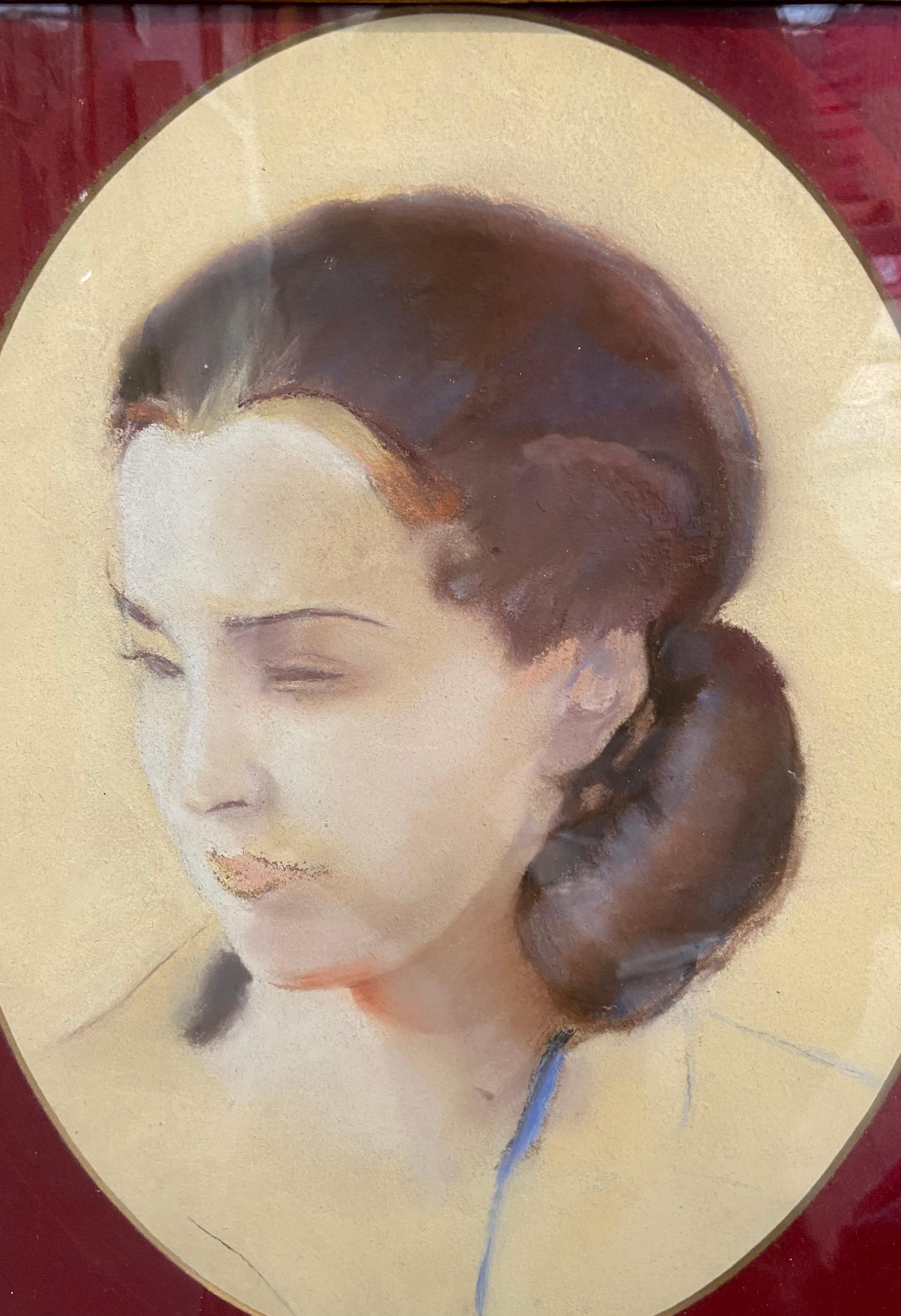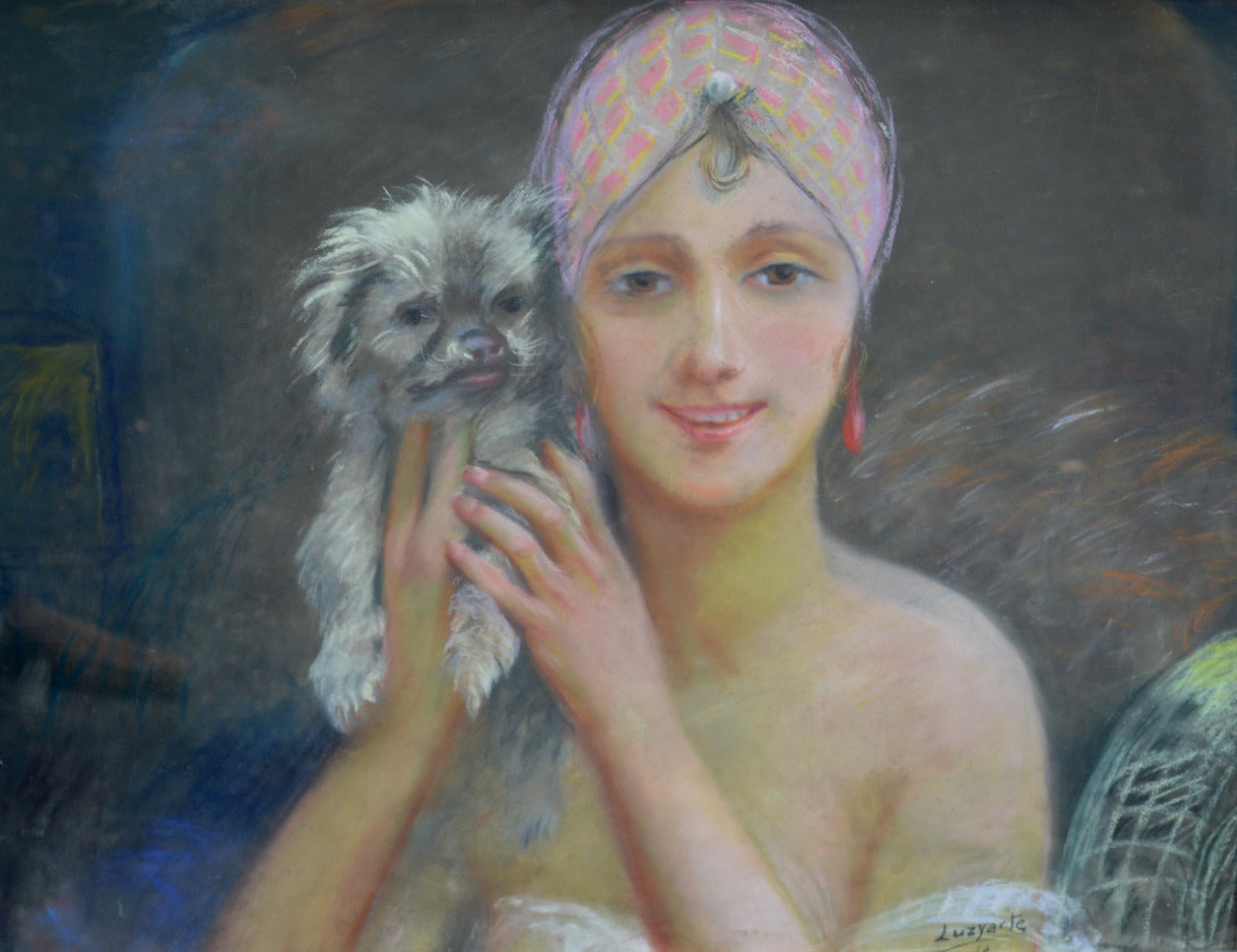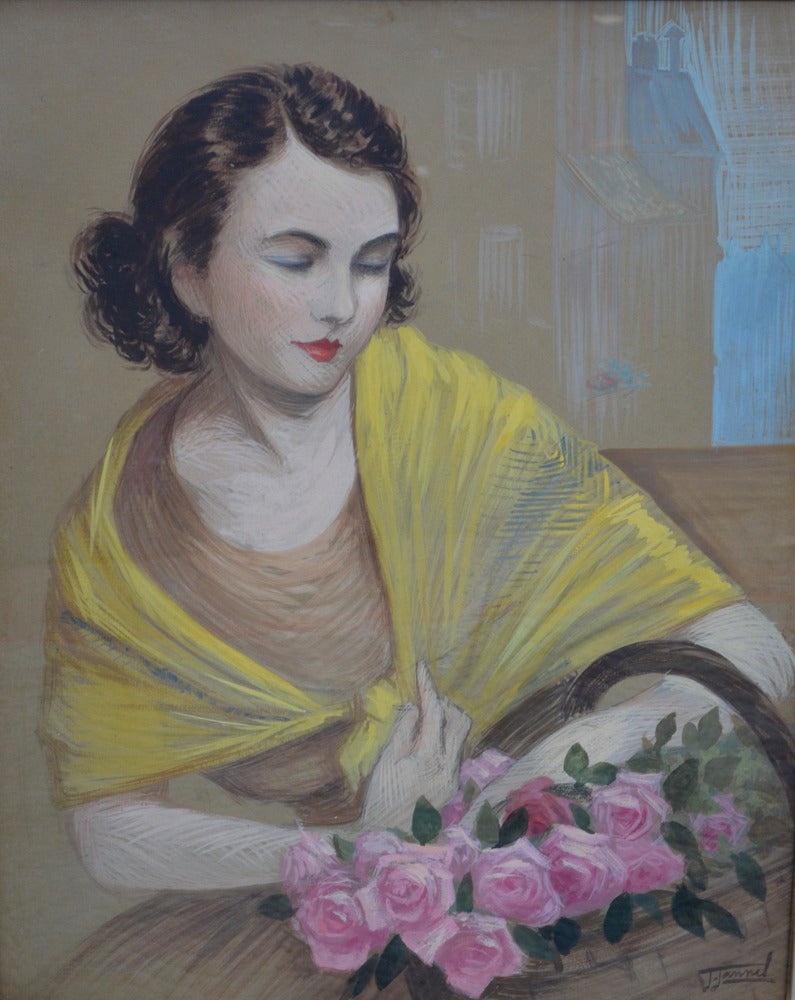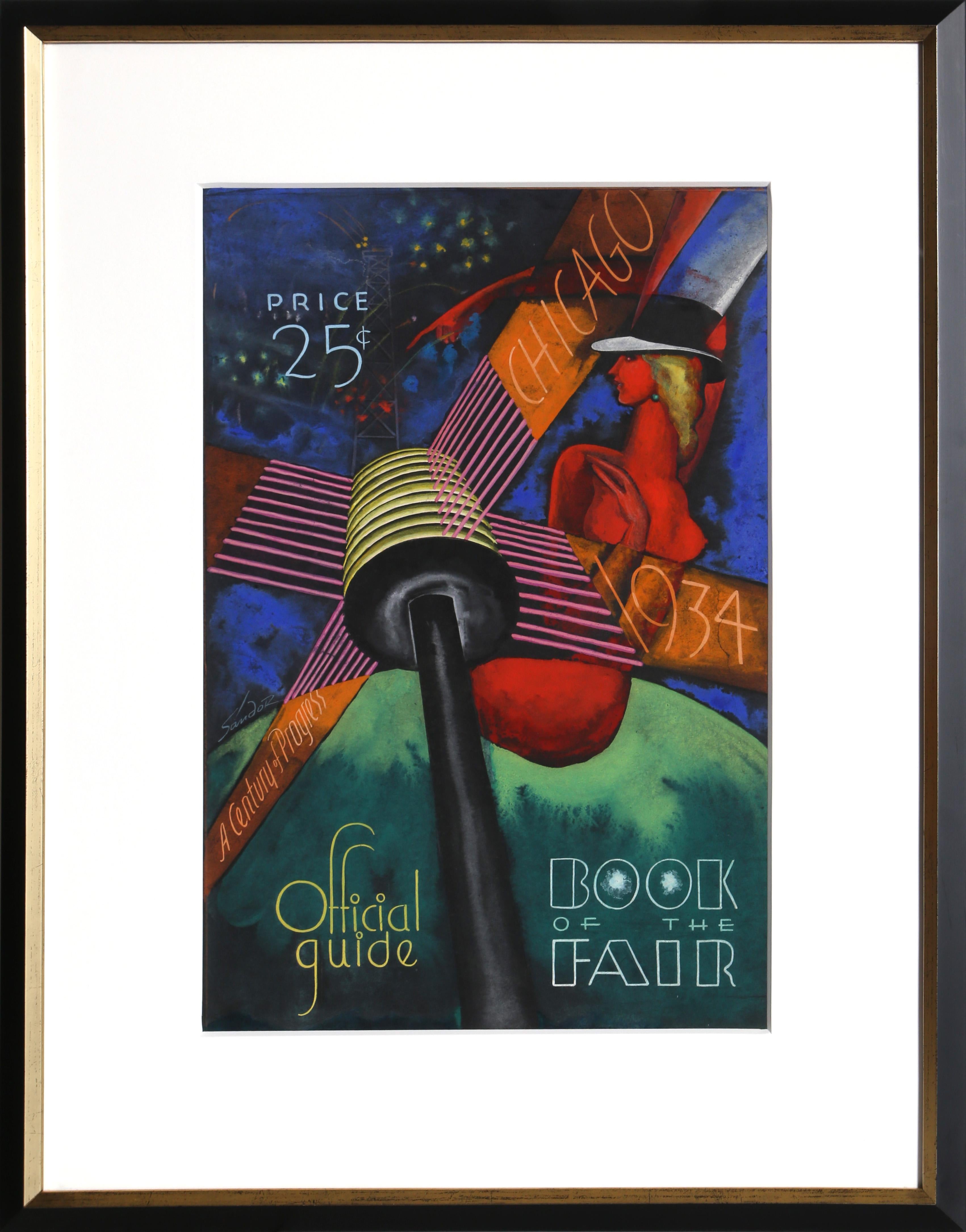Items Similar to Deco Woman
Want more images or videos?
Request additional images or videos from the seller
1 of 9
William SommerDeco Womanc. 1918-20
c. 1918-20
About the Item
Deco Woman
Crayon on paper, c. 1920
Signed in ink lower left: "Wm. Sommer" (see photo)
Provenance:
Estate of the artist
Edwin Sommer (the artist’s son)
Joseph Erdelac, Cleveland (JME inventory # verso)
Connie Erdelac (daughter)
Note: This drawing was executed in the early 1920s while Sommer was active in the Kokoon Klub.
Condition: Excellent
Image size: 15 1/4 x 11 inches
Frame: 25 1/8 x 21 1/8 inches
William Sommer
(1867-1949)
William Sommer is seen as a key person in bringing European modernism to Northeast Ohio. He was born in Detroit, Michigan, and in his youth apprenticed for seven years to a lithographer.
He briefly studied at an art academy in Germany and then worked as a lithographer in New York before moving to Cleveland, where he was awarded a major contract with the Otis Lithography Company. There he became friends with sculptor and painter William Zorach, and the two, determined to be fine artists, began painting together on weekends. They also became intrigued by avant-garde movements, especially after Zorach's trip to Paris in 1910.
In 1911, Sommer co-founded a group in Cleveland called the Kokoon Club, a mixed group of commercial artists and radical modernists who sought the freedom to pursue their independent tendencies. They converted a tailor's shop into a studio and held exhibitions and lectures and organized an annual masked ball that became the focus of Cleveland's bohemian life.
In 1913, he and his colleagues began painting at Brandywine, about 30 miles south of Cleveland and made a school house into a studio. They devoted increasing time to watercolor painting because they could work spontaneously and it would dry quickly. Rejecting the conventional ideas of beauty, they strove for the expression of emotion and spontaneity and fantasy. One of Sommer's most successful students was Charles Burchfield.
As he was perfecting his mature style, he had financial difficulties because he made his living from commercial lithography, which was becoming obsolete, and the Depression was hitting the nation causing him to lose his job. He became a WPA artist, doing murals in northeastern Ohio.
After his death at age 82, he was largely forgotten until 1980 when Hilton Kramer, a "New York Times" critic, praised his work. In May to July, 1994, the Ohio Arts Council held a retrospective of his work at the Riffe Gallery in Columbus. His work is found in many public collections including the National Museum of American Art, The Metropolitan Museum of Art, and the Whitney Museum of American Art.
Courtesy, AskArt
- Creator:William Sommer (1867-1949, American)
- Creation Year:c. 1918-20
- Dimensions:Height: 15.25 in (38.74 cm)Width: 11 in (27.94 cm)
- Medium:
- Movement & Style:
- Period:
- Condition:Original.
- Gallery Location:Fairlawn, OH
- Reference Number:
About the Seller
5.0
Recognized Seller
These prestigious sellers are industry leaders and represent the highest echelon for item quality and design.
Platinum Seller
These expertly vetted sellers are 1stDibs' most experienced sellers and are rated highest by our customers.
Established in 1978
1stDibs seller since 2013
711 sales on 1stDibs
Typical response time: 1 hour
Associations
International Fine Print Dealers Association
- ShippingRetrieving quote...Ships From: Fairlawn , OH
- Return PolicyA return for this item may be initiated within 10 days of delivery.
More From This SellerView All
- The Mouth of HoneyBy George Wesley BellowsLocated in Fairlawn, OHThe Mouth of Honey Lithographic crayon and mixed media on paper mounted to support paper Initialed by the artist "GB" bottom center on image. (see photo) Titled in pencil in bottom m...Category
1920s Ashcan School Drawings and Watercolor Paintings
MaterialsCrayon
- Double sided crayon drawing in colors: Study for "The Shoe" (recto)By Théophile Alexandre SteinlenLocated in Fairlawn, OHDouble sided crayon drawing: Front: Study for "The Shoe" Reverse: Studies of Figures Blue crayon, red and black crayons Image size: 19.25 x 15.375 inches Frame size: 30 x 25 1/2 inches Signed with the estate stamp, Lugt 2312b, recto and verso Annotated on verso in blue pencil: “On Demande des petites femmes...Category
1890s Art Nouveau Figurative Drawings and Watercolors
MaterialsCrayon
- Woman on a PatioBy Karl Albert BuehrLocated in Fairlawn, OHWoman on a Patio Pastel on paper, c. 1915 Unsigned Provenance: Gift of the artist to his wife, Mary Hess Buehr By decent to the artist's niece, daughter of Will Hess David Saltzman Robert Henry Adams Fine Art Thomas French Fine Art Ronald C. Sloter, Columbus, Ohio Columbus College of Art and Design (de-accessed) Exhibited at Robert Henry Adams Fine Art, 1994, the first exhibition at the North Franklin Street Gallery. One of the early Chicago artists to adopt Impressionism, Karl Buehr became a figure and landscape painter. As a figure painter, his specialty became "gorgeously colored images of young women on porches overlooking brilliant summertime gardens." (Kennedy 98) His later work often showed a female figure with serious expression engaging the viewer with a direct stare. In his landscapes, he was noted for his strong coloration. In a December 1896 student exhibition at the Art Institute, a reviewer for the "Chicago Times Herald" described Buehr's landscapes as "blithe and joyous" with "country roads brilliant in sunlight . . . fields rich in summer verdure, under soft skies painted in a high, musical key." (Gerdts 68) Buehr was born as one of seven sons to a prosperous German family who immigrated to America and settled in Chicago in 1869. He was first exposed to his signature style of Impressionism in 1888 when he enrolled in night classes at the Art Institute while working in the shipping department of a lithographic firm near the Institute. He remained a student there until 1897 and was recognized in a "Chicago Times Herald" editorial of June 13, 1897 as one of the Institute's most outstanding pupils. The next year, his art career was temporarily put on hold when he briefly enlisted with the U.S. Army in the Spanish American War. In 1899, he resumed his art studies, this time with Frank Duveneck. He exhibited a painting at the Paris Salon of 1900. In 1905, thanks to a wealthy Chicago patron, Buehr and his family moved to France. They spent the following year in Taormina, Sicily, and spent time in Venice as well. In Paris, Buehr studied at the Academy Julian with Raphael Collin for two years. Then he went to England, enrolling in the London Art School but had returned to Paris by 1908. During this time, he began painting at Giverny, the home of Impressionist leader Claude Monet (1840-1926, and by 1912, Buehr was listing that village as his home address. One of his good friends and associates at Giverny was Frederick Frieseke. One of Buehr's paintings from that time, "News from Home", was exhibited in 1913 at the French Salon in Paris and at the annual exhibit of the Chicago Art Institute. It shows a woman in floral dress sitting on a porch with a background with potted flowers and lush greenery background. Of his painting done at Giverny, Buehr wrote in 1912 to William Macbeth of Macbeth Galleries in New York: "My figures painted in and around Giverny are costumed and in appropriate out door settings." (Gerdts 68) In 1914, he returned to the United States and took a teaching position in Chicago at the Art Institute, which he held for the remainder of his life. He was married to Mary Hess, a painter of miniatures and decorative works. In 1928-29, he was a guest artist at Stanford University. Courtesy, AskArt “Karl Albert Buehr (1866–1952) was a painter born in Germany. Buehr was born in Feuerbach - near Stuttgart. He was the son of Frederick Buehr and Henrietta Doh (Dohna?). He moved to Chicago with his parents and siblings in the 1880s. In Chicago, young Karl worked at various jobs until he was employed by a lithograph company near the Art Institute of Chicago. Introduced to art at work, Karl paid regular visits to the Art Institute, where he found part-time employment, enabling him to enroll in night classes. Later, working at the Institute as a night watchman, he had a unique opportunity to study the masters and actually posted sketchings that blended in favorably with student's work. Having studied under John H. Vanderpoel, Buehr graduated with honors, while his work aroused such admiration that he was offered a teaching post there, which he maintained for many years thereafter. He graduated from the Art Inst. of Chicago and served in the IL Cav in the Spanish–American War. Mary Hess became Karl's wife—she was a student of his and an accomplished artist in her own right. In 1922, he was elected into the National Academy of Design as an Associate member. Art Studies in Europe In 1904, Buehr received a bronze medal at the St. Louis Universal Exposition, then, in 1905, Buehr and his family moved to France, thanks to a wealthy Chicago patron, and they spent the following year in Taormina, Sicily, where the artist painted local subjects, executing both genre subjects and landscapes as well as time in Venice. Buehr spent at least some time in Paris, where he worked with Raphaël Collin at the Académie Julian. Giverny and American Impressionism Prior to this time, Buehr had developed a quasi-impressionistic style, but after 1909, when he began spending summers near Monet in Giverny, his work became decidedly characteristic of that plein-air style but he began focusing on female subjects posed out-of-doors. He remained for some time in Giverny, and here he became well-acquainted with other well known expatriate America impressionists such as Richard Miller, Theodore Earl Butler, Frederick Frieseke, and Lawton Parker. It seems likely that Buehr met Monet, since his own daughter Kathleen and Monet’s granddaughter, Lili Butler, were playmates, according to George Buehr, the painter’s son. His other daughter Lydia died before adulthood due to diabetes. He returned to Chicago at the onset of World War I and taught at The Art Inst for many years. One of his noted pupils at the Art Institute was Archibald Motley...Category
1910s Abstract Impressionist Figurative Drawings and Watercolors
MaterialsPastel
- CourtshipBy Robert HenriLocated in Fairlawn, OHCourtship Graphite and black crayon, c. 1905 Signed by the artist in pencil lower left (see photo) Most probably inspired by a Paul Gavarni lithograph and executed while the artist w...Category
Early 1900s American Impressionist Figurative Drawings and Watercolors
MaterialsCrayon
- Untitled (Joe and Patsy LoGuidice at the Casa Luna)By Larry RiversLocated in Fairlawn, OHUntitled (Joe and Patsy LoGuidice at the Casa Luna) Pastel, charcoal and colored pencil, 1970-1975 Signed lower right in pencil: Larry Rivers Inscribed on the rabbit of the original white frame: LOGUIDICE in ink Provenance: Private Collection, New York (Westchester County) Condition: Excellent Image size: 31 1/2 x 24 1/2 inches Frame size: 39 1/2 x 32 1/2 inches Note: The image depicts Ciprian “Joe” LoGuidice (d. 2008) and his wife Patsy with their dog (Golden Retriever?) in their famous house Casa Luna, located in Zihautenajo, Mexico. Joe LoGuidice had a most colorful life as stated in his memorial posting by Pam Barkentin: Ciprian "Joe" LoGiudice, of Los Angeles and Zihautanejo, Mexico Art Dealer, Political Activist, Environmentalist, Film Producer, and Executor of the Terry Southern Estate died at home in Los Angeles on September 3, 2008. A major benefactor of the Chicago Seven, he hosted a benefit for the anti-war activists at his Ontario Street Gallery in Chicago and later harbored the fugitive Abbie Hoffman in Zihautenajo where Joe designed and built the famous Casa Luna, the house without walls, in a compound that included Larry River's Studio as well as the garden where Julian Schnabel painted with the assistance of Ramon Pedrazo, Joe's gardener and the husband of his faithful housekeeper, Concha Pedrazo. Here at Casa Luna, from the early seventies on, Joe and his wife, Patsy, generously hosted friends and enemies alike with great enthusiasm and humor.Most recently, through his participation in "Save the Bay", Joe was instrumental in preventing cruise ships from anchoring in the Bay of Zihautanejo. He was also producing "Five Easy Steps to Metaphysical Fitness", a documentary about the philosopher/comic, Emily Levine. Christo's first wrapping of a building in the United States, the Chicago Museum of Art, was produced by LoGiudice. Other artists he represented, in both his Chicago and New York Galleries, included John Chamberlin, Larry Poons, Mark de Suvero, Leon Golub and Jules Olitski. Joe is survived by his wife of 25 years, Patsy Cummings. An important work by Rivers showing his friend and art dealer in their famous house, Casa Luna, in Mexico. The cultural import of LoGuidice cannot be understated. He was a major figure in the New York, Chicago, and Los Angeles art cultures. The artist’s who were his friends and guests were many of the leading icons of late 20th century art. Larry Rivers Larry Rivers in 1961 Born Yitzroch Loiza Grossberg August 17, 1923 Bronx, New York, U.S. Died August 14, 2002 (aged 78) Southampton, New York, U.S. Nationality American Education Hans Hofmann School Known for Painting, sculpture Movement East Coast figurative painting, new realism, pop art Spouse(s) Augusta Berger (m. 1945; div. 1946) Clarice Price (m. 1961; sep. 1967) Larry Rivers (born Yitzroch Loiza Grossberg, August 17, 1923 – August 14, 2002) was an American artist, musician, filmmaker and occasional actor. Rivers resided and maintained studios in New York City, Southampton, Long Island, and Zihuatanejo, Mexico. Early life Larry Rivers was born in the Bronx to Samuel and Sonya Grossberg, Jewish immigrants from Ukraine. From 1940–1945 he worked as a jazz saxophonist in New York City, changing his name to Larry Rivers in 1940 after being introduced as "Larry Rivers and the Mudcats" at a local pub. He studied at the Juilliard School of Music in 1945–46, along with Miles Davis, with whom he remained friends until Davis's death in 1991. Training and career Larry Rivers in 1961 Rivers is considered by many scholars to be the "Godfather" and "Grandfather" of Pop art, because he was one of the first artists to really merge non-objective, non-narrative art with narrative and objective abstraction. Rivers took up painting in 1945 and studied at the Hans Hofmann School from 1947–48. He earned a BA in art education from New York University in 1951. He was a pop artist of the New York School, reproducing everyday objects of American popular culture as art. He was one of eleven New York artists featured in the opening exhibition at the Terrain Gallery in 1955. During the early 1960s Rivers lived in the Hotel Chelsea, notable for its artistic residents such as Bob Dylan, Janis Joplin, Leonard Cohen, Arthur C. Clarke, Dylan Thomas, Sid Vicious and multiple people associated with Andy Warhol's Factory and where he brought several of his French nouveau réalistes friends like Yves Klein who wrote there in April 1961 his Manifeste de l'hôtel Chelsea, Arman, Martial Raysse, Jean Tinguely, Niki de Saint-Phalle, Christo, Daniel Spoerri or Alain Jacquet, several of whom left, like him, some pieces of art in the lobby of the hotel for payment of their rooms. In 1965 Rivers had his first comprehensive retrospective in five important American museums. His final work for the exhibition was The History of the Russian Revolution, which was later on extended permanent display at the Hirshhorn Museum and Sculpture Garden in Washington, DC. During 1967 he was in London collaborating with the American painter Howard Kanovitz. In 1968, Rivers traveled to Africa for a second time with Pierre Dominique Gaisseau to finish their documentary Africa and I, which was a part of the groundbreaking NBC series Experiments in Television. During this trip they narrowly escaped execution as suspected mercenaries.[citation needed] During the 1970s Rivers worked closely with Diana Molinari and Michel Auder on many video tape projects, including the infamous Tits, and also worked in neon. Rivers's legs appeared in John Lennon and Yoko Ono's 1971 film Up Your Legs Forever. Personal life Rivers married Augusta Berger in 1945, and they had one son, Steven. Rivers also adopted Berger's son from a previous relationship, Joseph, and reared both children after the couple divorced. He married Clarice Price in 1961, a Welsh school teacher who cared for his two sons. Rivers and Clarice Price had two daughters, Gwynne and Emma. After six years, they separated. Shortly after, he lived and collaborated with Diana Molinari, who featured in many of his works of the 1970s. After that Rivers lived with Sheila Lanham, a Baltimore artist...Category
1970s Contemporary Figurative Drawings and Watercolors
MaterialsPastel
- Next Door NeighborBy Sedrick HuckabyLocated in Fairlawn, OHNext Door Neighbor Oil pastel and ink on handmade paper, 2012 Signed vertically lower left in image (see photo) Series: 99% Exhibited: Swarthmore College, List Gallery, Hiden in Pla...Category
2010s Figurative Drawings and Watercolors
MaterialsOil Crayon
You May Also Like
- L V Guirand de Scevola (1871-1950) Portrait of a young woman, 1928, oval pastelBy Lucien-Victor Guirand de ScévolaLocated in Paris, FRLucien-Victor Guirand de Scevola (1871-1950) Portrait of a young woman Pastel on paper 38 x 28 cm (oval) Framed under glass in a vintage framing : 45 x 35 cm A label on the back "1928 Portrait de femme Etude au pastel de Guirand de Scévola" (see photographs please) This pastel study is of course not signed, as the label on the back of the frame gives its attribution to Guirand de Scévola and, equally interestingly, the date 1928, but in fact the artist's style and execution are immediately recognisable without the need for a signature. This type of woman with a bun is typical of the models the artist loved. Her mysterious air recalls his Symbolist period, and pastel is hisr preferred medium because it lends itself to all the characteristics typical of his art. Lucien-Victor Guirand de Scévola ( 1871 – 1950) was a French painter. He was student of Fernand Cormon and Pierre Dupuis...Category
1920s Art Deco Portrait Drawings and Watercolors
MaterialsPastel
- Les AmieBy Fernando LuziarteLocated in West Hollywood, CAPresenting an original pastel on paper by Fernando Luziarte. "Les Amie" is an original pastel, signed, dated 1924, with an image dimesnion of 19 x 25 inches, offered in good origi...Category
1920s Art Deco Figurative Drawings and Watercolors
MaterialsPastel
- Femme et ChienBy Fernando LuziarteLocated in West Hollywood, CAPresenting an exceptional Art Deco original pastel by Spanish artist Fernando Luziarte. "Femme et Chien", is an original pastel, signed, dated 1924, with an image dimension of 19 ...Category
1920s Art Deco Figurative Drawings and Watercolors
MaterialsOil Pastel, Paper
- FleursBy Jean JannelLocated in West Hollywood, CAAn original Pastel by French artist Jean Jannel, known for his figurative, genre portraits. Fleurs, is an original pastel on paper, signed, c.1930, offered superbly framed.Category
1930s Art Deco Figurative Paintings
MaterialsOil Pastel, Paper
- La PromenadeBy Georges Henri Manzana PissarroLocated in London, GBCharcoal and pastel on paper 49.5 x 63.5 cm (19 ⅜ x 25 inches) Signed lower left, Manzana Executed circa 1920 This work is accompanied by a certificate of authenticity issued by L...Category
1920s Art Deco Animal Drawings and Watercolors
MaterialsCharcoal, Pastel
- World's Fair 1934 (Chicago), Art Deco Drawing by A. Raymond KatzBy Alexander Raymond KatzLocated in Long Island City, NYThis is the original drawing for the cover of the Chicago World's Fair Guide Book by A. Raymond Katz (1895 - 1974). This design was used in variation on the guide book, posters and ...Category
1930s Art Deco Figurative Drawings and Watercolors
MaterialsOil Pastel




